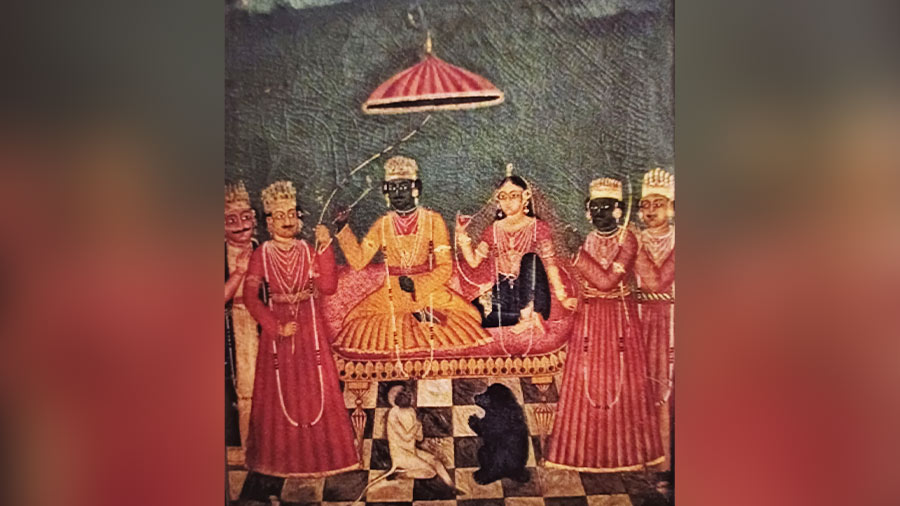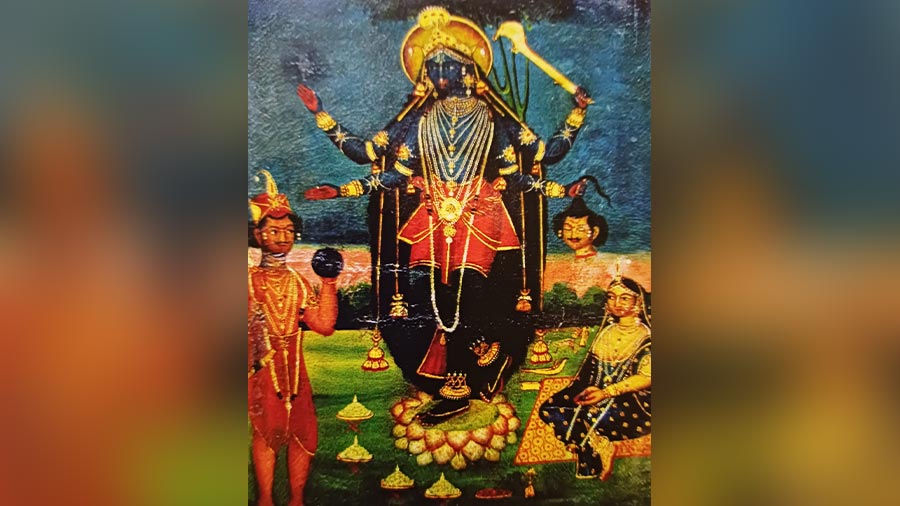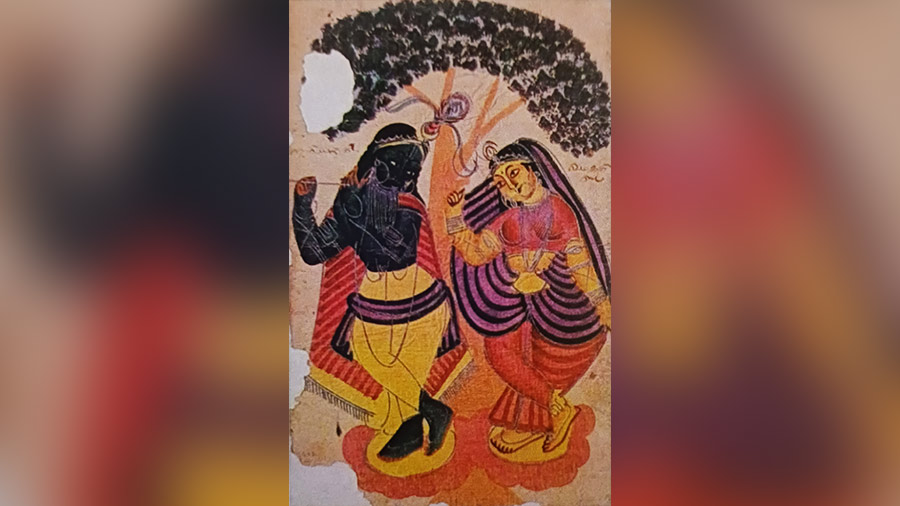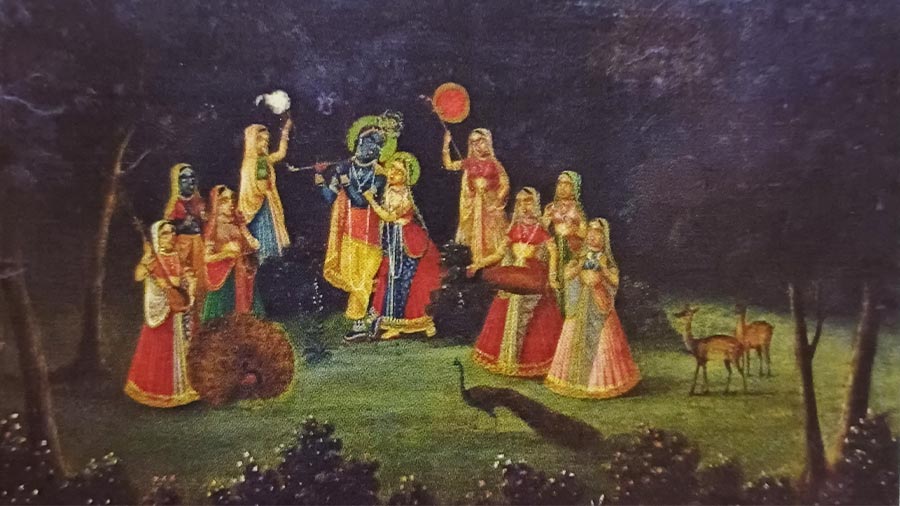Amid the rich tapestry of history and the vibrant hues of Bengal’s artistic heritage, Khokon Raut’s magnum opus, titled Early Bengal Oil Paintings (Aayu Publications, 2023), beckons readers to embark on a captivating journey into the past, where canvases adorned with pigments reveal the secrets of a bygone era. Raut, a distinguished expert in the field, penned this remarkable work during his tenure as an assistant professor at the Department of Visual Arts at the University of Kalyani, where his research endeavours first took root.

An early Bengal oil painting, oil on canvas, 50.8 cm x 61 cm, CIMA Gallery, Kolkata
Striking a harmonious balance
The book’s narrative unfolds against the backdrop of the pioneering invention of oil painting by Jan van Eyck, an artistic milestone that ushered in an era characterised by unparalleled precision, vibrancy, and enduring beauty. While oil painting began to make its mark on the Indian canvas during the 18th century, owing to growing European influences on art and culture, it wasn’t until the 19th century that this technique found wider acceptance within Indian artistic traditions. Raut’s book serves as a tribute to this little-explored history, born from meticulous visits to galleries, museums, and the historic zamindar residences scattered across north Kolkata, Chandannagar, Chinsurah, Mankundu, and Hooghly.

‘Krishna Kali’, 43 cm x 31.7 cm, oil on canvas, Chitrakoot Art Gallery, Kolkata
What instantly captivates the reader is the book’s remarkable ability to strike a harmonious balance. It offers profound insights and meticulous analyses that will satisfy the discerning art historian, while simultaneously remaining accessible and engaging for the more casual art enthusiast. As such, it stands as an invaluable resource that caters to a diverse range of readers.
An evolving artistic landscape
The book embarks on its journey in the first chapter, tracing the evolution of oil painting from its inception, as a refinement of the tempera technique, to its transition into a medium characterised by efficient drying rates and nuanced tonal mixing. Raut then shifts his focus to the introduction of oil painting in the Indian subcontinent, largely attributed to the East India Company. Here, luminaries such as George Lambert and Samuel Scott come to the fore, celebrated for their iconic oil depictions of Fort William in Calcutta. The subsequent section presents a meticulous examination of the political and social dimensions of early Bengal oil paintings, some of which now grace the esteemed homes of aristocratic families like the Ghosh family of Pathuriaghata and the Kha family of Mankundu, forging a captivating link between the past and the present.

‘Old Fort William from the River Hooghly’ by George Lambert and Samuel Scott, oil on canvas (c. 1730)
The following chapters pivot towards external influences on Bengal’s art and the consequential aesthetic enrichment of the region. Raut deftly navigates readers through the world of folk art and the influential artists of Bengal, underscoring the impact of social and religious factors on the evolving artistic landscape.
Onto another dimension
In stark contrast, the ensuing section exemplifies rigorous scholarship and meticulous analysis. It delves into the intricate nuances of the Mughal, Rajasthani, Murshidabad, and patachitra schools of painting, unravelling their distinctive characteristics. Furthermore, it illuminates the profound influence of the East India Company on the evolution of these artistic styles. Raut’s comprehensive research and comparative case studies provide readers with an in-depth understanding of artistic styles, the technical aspects of oil paintings, their layered complexities, and invaluable insights into conservation techniques. An exhaustive bibliography serves as a treasury of resources, inviting readers to delve deeper into their own research and enrich their knowledge of one of eastern India’s most intricate art forms.

An example of the Kalighat style of painting
In Early Bengal Oil Paintings, Raut has skillfully woven together the threads of history and artistry to create a tapestry that captures the essence of Bengal’s rich cultural heritage. This book not only serves as a testament to Raut’s expertise, but also as a bridge connecting the past and the present through the vibrant strokes of oil paintings. With its meticulous research, insightful analyses, and accessibility to a broad readership, Early Bengal Oil Paintings is a treasure trove for both seasoned art historians and those who simply appreciate the beauty of art. It encourages us to look back in time and rediscover the forgotten, offering a profound understanding of Bengal’s artistic evolution. Raut’s work reminds us that art is not merely a reflection of the past, but a timeless expression of human creativity that continues to inspire and connect generations.
